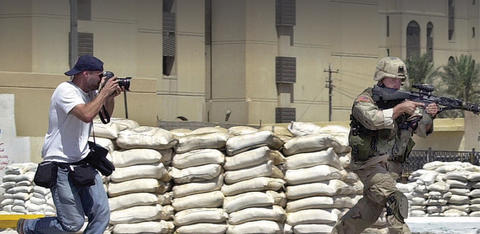Giovanna Dell’Orto interviewed 61 foreign correspondents across the globe, illuminating eight decades of Associated Press reportage.
By Chelsea Reynolds
What did it take to produce foreign news throughout the last century? How did journalists decide what was newsworthy for U.S. audiences during times of international turmoil? These are the questions that drove associate professor Giovanna Dell’Orto to traverse five continents for her most recent book, AP Foreign Correspondents in Action: World War II to the Present (2015, Cambridge University Press).
As a former Associated Press reporter, Dell’Orto wanted to tell the story of foreign news coverage by turning to its source. A research sabbatical funded by the College of Liberal Arts and the Office of the Vice President for Research allowed her to travel and speak with 61 AP journalists in South Korea, Spain, Morocco, Mexico and many countries in between. Almost all of the interviews were conducted in person. Many of her sources were in their 80s or 90s. Two were the last living reporters who covered World War II for AP.
“It was very important to me to get these voices before, frankly, they disappear from the record,” Dell’Orto said.
In total, the sources had 1,710 years of experience as AP foreign correspondents—more than 28 years each on average. During the interviews, Dell’Orto asked the foreign correspondents questions about the reporting process at times of conflict during which they worked. She wanted to tease out how these journalists understood newsworthiness. She wanted to know what made the journalists tick.
Dell’Orto hoped to record memories of the everyday routines in newsrooms staffed by everyday news workers.
An important part of the project was to gather oral histories from nonfamous reporters. With two or three exceptions, the AP journalists Dell’Orto spoke with are not well-known outside of professional circles. “I just wanted this to be about people whose names we don’t know, but who are really the most important shapers of Americans’ worldviews,” she said.
Dell’Orto transcribed every interview with the help of then-SJMC Ph.D. students Rodrigo Zamith and Stephen Bennett. (“They probably still have blisters on their hands, as they told me, from all of this transcribing,” she joked.) Dell’Orto then analyzed the corpus of stories for themes in the foreign correspondents’ testimonies.
A major thread in the narratives was technology change and the challenges it presents in the field. Those who worked in the 1970s described early computers in the newsroom, while today’s journalists waxed on about social media and online distribution.
“There is a lot of behind-the-scenes history that has never been studied before because journalists are not interested in themselves usually,” Dell’Orto said. “They’re interested in what they’re covering, so they almost never go back to write about what they experienced.”
AP Foreign Correspondents in Action gives readers a look into the minds of news producers across history and geographies, offering them first-hand insights into the psyches of foreign correspondents. “I really got the sense that to them, this is so much more than a job,” Dell’Orto said. “It really is. It’s almost a moral imperative.”
For more from Dell'Orto, read Bringing Home the World, her article on the challenges of foreign correspondence.
